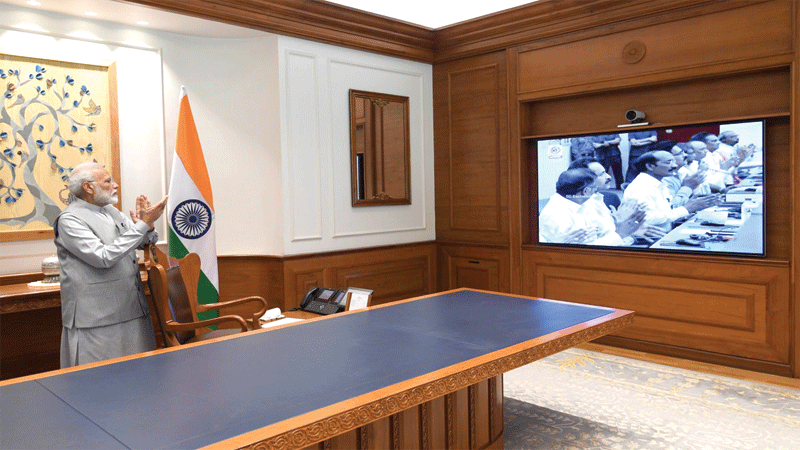India, fourth country after Russia, US and China to pull off a soft landing on moon
India on 22 July, 2019 successfully launched its second moon mission Chandrayaan-2 from its most powerful rocket with a plan to land the rover on 07 September in the unexplored lunar South Pole, exactly a week after the liftoff was aborted due to a technical snag.
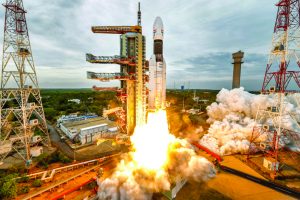
Carrying a “billion dreams” in a giant leap for the country’s ambitious low-cost space programme, the most complex and prestigious mission ever undertaken by the Indian Space Research Organisation(ISRO), will also make India the fourth country after Russia, the US and China to pull off a soft landing on the moon.
“We bounced back with flying colors after the earlier technical snag. Success is coming after a call-off,” said a beaming and visibly relieved ISRO Chairman K Sivan at the mission control room of the Satish Dhawan Space Centre in Sriharikota, about 100 km from Chennai, as scientists broke into cheers, shook hands and exchanged greetings.
ISRO Chairman, who announced the success of the mission, was addressing the scientists shortly after the towering geosynchronous satellite launch vehicle GSLV-MkIII-M1, dubbed as ‘Baahubali’, lifted-off from the second launch pad at the spaceport into cloudy skies at 2.43 pm and successfully placed the 3,850-kg Chandrayaan-2 into the earth orbit about 16 minutes later.
Mission is “Indian at heart, Indian in spirit”
Joined by President Shri Ram Nath Kovind and leaders across the political spectrum, Prime Minister Shri Narendra Modi congratulated the scientists and said every Indian is immensely proud today.
In a series of tweets, PM Shri Modi referred to the indigenous systems used in Chandrayaan-2 and said the mission is “Indian at heart, Indian in spirit! “Efforts such as Chandrayaan-2 will further encourage our bright youngsters towards science, top quality research and innovation.”
The Prime Minister also shared pictures of him watching the launch on a large screen and shared his audio message to the ISRO.
“Chandrayaan-2 is unique because it will explore and perform studies on the South Pole region of lunar terrain which is not explored and sampled by any past mission. This mission will offer new knowledge about the moon,” Shri Modi said.
About the mission
The ISRO is aiming for a soft landing of the lander in the South Pole region of the moon where no country has gone so far.
Immediately after Chandrayaan-2’s separation from the rocket, the solar array of the spacecraft automatically got deployed and the ISRO Telemetry, Tracking and Command Network at Bengaluru successfully took control of the spacecraft, the ISRO said in a statement.
According to the statement, Chandrayaan-2, a three-module spacecraft comprising orbiter, lander and rover, will be subjected to a series of orbit manoeuvres using its onboard propulsion system to take it to the vicinity of Moon over the next few weeks with the rover soft landing planned on September 7.
The mission was called off on July 15 barely an hour before the planned post-midnight lift-off after scientists noticed a glitch in the three-stage rocket during the propellant filling phase in the indigenous cryogenic engine, a decision that was welcomed as a prudent step by the Indian space fraternity.
ISRO Chairman said immediately after the technical snag was observed in an “intelligent way” one week back, the entire team swung into action. “The work done in the next 24 hours to bring the vehicle back to normal was mind-boggling.”
Scientists led by ISRO Chairman Sivan watched the launch sequence in rapt attention and broke into applause after every key stage of the rocket’s flight which progressed precisely as programmed. “It is the beginning of a historical journey of India towards the moon,” Sivan said.
There will be 15 “very crucial manoeuvres” in the next one and half months before the satellite is brought around the moon, he said.
“After that the D-Day will come and on that day we are going to experience 15 minutes of terror, to ensure the landing is safe near the South Pole,” he added.
According to the ISRO, the lunar South Pole is an interesting surface area which remains in shadow than North Pole.
There is a possibility of the presence of water in permanently shadowed areas around it, the agency said, adding craters in the South Pole region have cold traps and contain fossil record of the early solar system.
Anxiety gave way to unbridled joy for thousands of space enthusiasts gathered here after the successful launch. The 7,500 seat gallery set up by the ISRO to witness the rocket launch, a few kilometers away from the second launch pad, was full with those registering last week for the July 15 launch, rebooking their seats.
Chandrayaan-2 comes 11 years after ISRO’s successful first lunar mission Chandrayaan-1 which scripted history by making more than 3,400 orbits around the Moon and was operational for 312 days till August 29, 2009.
The 43.43-metre tall three-stage rocket GSLV-MkIII-M1 dubbed as Baahubali for its ability to carry heavy payloads, successfully placed the Chandrayaan-2 in the Earth orbit, ISRO said.
From here onwards, the mission will undergo a series of manoeuvres by scientists to carry out different phases of the mission over the next 48 days. Subsequent to the rescheduling of the launch, the space agency has tweaked the orbital phases, increasing Earth-bound phase to 23 days as against 17 days planned originally.
At the end of the Earth-bound phase, the orbit of the spacecraft will be finally raised to over 1.05 lakh km before nudging it into the Lunar Transfer Trajectory taking it to the proximity of Moon in the next two days.
Then gradually over the next few days it will be brought to 100 X 100 km circular orbit when the lander ‘Vikram’ carrying rover ‘Pragyan’ will separate and after another few days of orbiting it will make a soft landing at a chosen place on the Lunar surface.
“Chandrayaan-2 is the next leap in technology as we attempt to soft land close to South Pole of Moon. The soft landing is extremely complex…,” Sivan had said.
The mission, which carries a total of 13 payloads, including three from the Europe, two from the US and one Bulgaria, seeks to improve understanding of the moon which could lead to discoveries that will benefit India and humanity as a whole.
A Laser Retro reflector Array (LRA) of US space agency NASA is among the payloads and is aimed at understanding dynamics of Earth’s moon system and deriving clues on Lunar interior.
The lander Vikram, named after father of Indian space research programme Dr Vikram A Sarabhai, carrying the rover Pragyan, will be landed in a high plain between two craters at a latitude of about 70 degrees South of the moon. Then the 27-kg Pragyan meaning wisdom in Sanskrit and a six-wheeled robotic vehicle, will set out on its job of collecting information on lunar surface.
A safe site free of hazards for landing would be decided based on pictures sent back by the camera onboard the lander and after touchdown the rover will carry out experiments for 14 Earth days, equaling one Lunar Day.
How foreign media reacted to Chandrayaan 2 launch
Almost all top media houses across the world covered the giant leap of India’s space programme of launching a second Moon mission, the Chandrayaan 2, on 22 July, 2019. And almost every media house headlined the news on how ISRO managed the launch on its second attempt.
The New York Times (NYT), wrote, “India Launches Chandrayaan-2 Moon Mission on Second Try”.
The article authored by Jeffrey Gettleman and Hari Kumar speaks about how nothing unites a nation better than a space programme. The NYT wrote, “This would be a huge leap forward for India’s ambitious space program, and scientists and defense experts everywhere are watching to see whether the country can pull it off.”
It added, “So are countless Indians. There are few things as unifying for a nation as a successful space program, and, over the past few weeks, Chandrayaan-2 posters have popped up everywhere and schoolchildren have been hunched over mini-Chandrayaans made from empty plastic bottles, learning the physics of rocketry.”
The Washington Post said, “We have liftoff! India launches moon mission on second attempt.”
The CNN said, “Success in India’s second attempt at launching moon mission”. CNN’s report talks about how ISRO overcame the technical snag to manage a successful liftoff on 22 July, 2019 afternoon. “The country’s latest lunar mission, Chandrayaan-2, which means “moon vehicle” in Sanskrit, took off from the Satish Dhawan Space Center at Sriharikota in Andhra Pradesh state at 2:43 p.m., local time,” wrote CNN’s Helen Regan and Manveena Suri.
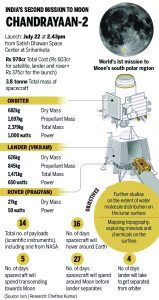
The Aljazeera said, “India’s moon mission Chandrayaan-2 gets off the ground”.
British online newspaper The Independent said, “India launches Chandrayaan-2 mission to the Moon after calling off previous attempt”.
The Guardian said, “India’s Chandrayaan-2 moon mission lifts off a week after aborted launch”.
The BBC headline said, “Chandrayaan-2: India launches second Moon mission”. India soared towards the South Pole of the Moon in a major success of its space programme with the launch of Chandrayaan 2. The second Moon mission will land a rover on the lunar surface in a first for the country. It is also the first time a country is attempting to explore the uncharted South Pole of the Moon. India will be only the fourth nation after the US, China and Russia to land on the Moon.
President Ramnath Kovind
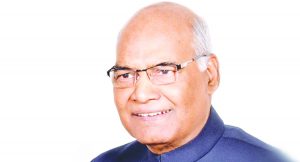
The historic launch of #Chandrayaan2 from Sriharikota is a proud moment for all Indians. Congratulations to our scientists and engineers for furthering India’s indigenous space programme. May @ISRO continue to master new technologies, and continue to conquer new frontiers.
#Chandrayaan2 will be the first spacecraft to land close to the moon’s South Pole in some 50 days from now. The mission is expected to lead to new discoveries and enrich our knowledge systems. I wish the Chandrayaan-2 team every success # PresidentKovind.
Narendra Modi @narendramodi
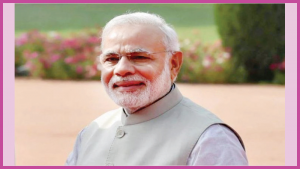
Special moments that will be etched in the annals of our glorious history! The launch of #Chandrayaan2 illustrates the prowess of our scientists and the determination of 130 crore Indians to scale new frontiers of science. Every Indian is immensely proud today!
Amit Shah @AmitShah
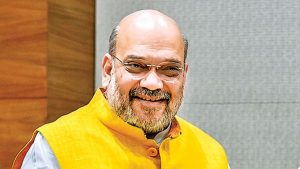
I congratulate our scientists at @isro for the successful launch of #Chandrayaan2 and setting yet another benchmark in the field of space technology. A grateful nation is proud of them. I also thank PM Modi ji for encouraging our institutions for setting new standards everytime.
Jagat Prakash Nadda @JPNadda
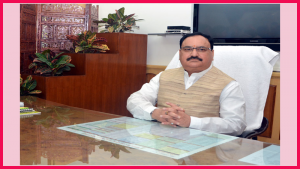
130 करोड़ भारतीयों के लिए यह गर्व का विषय है, कि पूर्णतया स्वदेशी #Chandrayaan2 चंद्रमा के दक्षिणी ध्रुव पर उतर कर चंद्रमा की सतह का अध्ययन, विश्लेषण आदि शोध कार्य करेगा। जहां पर अभी तक कोई नहीं पहुंच पाया आज वहां भारत की पहुंच है। इस अभियान से जुड़ी @isro टीम को हृदय से बधाई।
Rajnath Singh @rajnathsingh
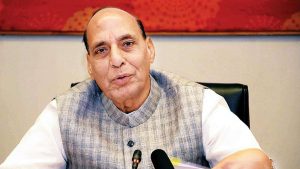
Congratulations to ISRO scientists on flawless launching of #Chandrayaan2 from Sriharikota. Team ISRO scripted a new chapter in India’s space history with the launch of this ambitious and indigenous Mission to Moon. The nation is extremely proud of its scientists and Team ISRO.
Dr Harsh Vardhan @drharshvardhan
Heartiest congratulations to @isro and Hon’ble PM Sh @narendramodi ji for today’s Chandrayaan-2 launch ! Indeed a big leap for ISRO and India as #Chandrayaan-2 majestically takes off for the moon.
Yogi Adityanath @myogiadityanath
130 करोड़ भारतीयों के सपनों को लेकर चांद की उड़ान भरने वाले #चंद्रयान2 के सफल प्रक्षेपण के लिए @isro के वैज्ञानिकों को हार्दिक शुभकामनाएं। कक्षयान, ‘विक्रम’ लैंडर और ‘प्रज्ञान’ रोवर से लैस यह यान चंद्र अन्वेषण में अप्रतिम योगदान देकर अंतरिक्ष विज्ञान में नया आयाम स्थापित करेगा।
Devendra Fadnavis @Dev_Fadnavis
Extremely proud moment & a very special day for India ! Congratulations to #TeamISRO for successful launch of #Chandrayaan2 ! India is very proud…! Many congratulations to all our scientists for this great achievement !
Anand Mahindra @anandmahindra
Was waiting to see the @isro folks hug each other before breathing normally again! Validation of our cryogenic tech is a technological breakthrough. It will enable us to make many more moon missions. I stand & salute our scientists. They are deservedly our new celebrities.


